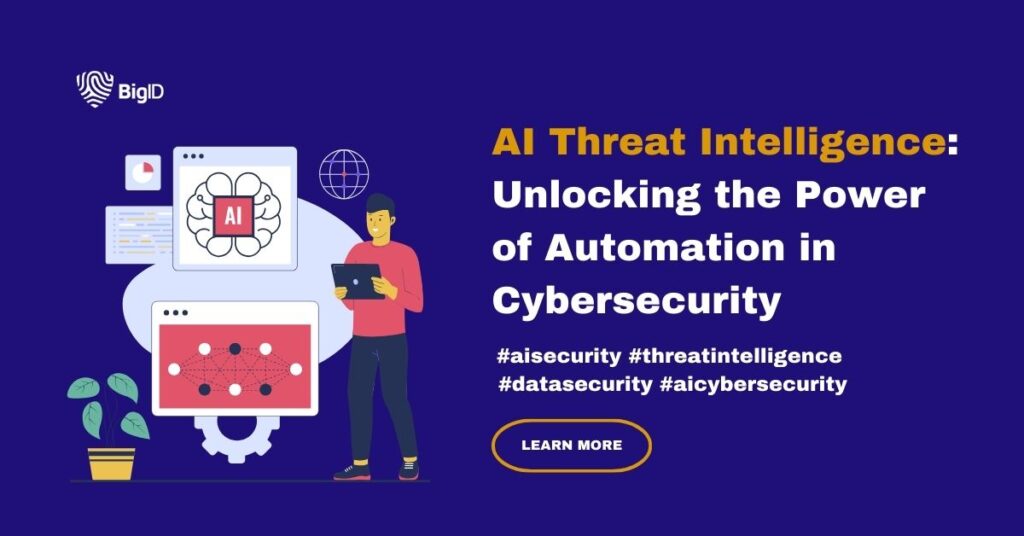Cyber crime is getting more sophisticated every day. That’s why artificial Intelligence has become an essential tool for safeguarding organizations from cyber threats. With a combination of vigilance and high-powered cyber intelligence, AI is invaluable when it comes to effective threat intelligence.
The Role of AI in Threat Intelligence and Cybersecurity?
AI technology, especially machine learning, has refined the automation of complex cybersecurity processes, and offers a proactive and intelligent defense against modern threats. It can easily be used to identify patterns, trends, and suspicious behaviors within extensive datasets. Email security, for example, can be greatly improved with AI-enabled threat intelligence. It can study content, sender details, attachments, and links to quickly identify and flag phishing attempts.
Additionally, AI helps enrich collected information by adding valuable context and metadata, such as geolocation and timestamps. This empowers security operators and incident responders with a comprehensive understanding to make more informed AI security decisions. The nuanced analysis often goes beyond human visibility.
Generative AI uses natural language processing (NLP) to understand the meaning and intent behind textual data. For example, it can extract threat data from various sources, such as reports, blogs, and news articles.
In the decision-making phase, AI’s prowess extends to reasoning and inference algorithms, enabling it to draw insightful conclusions and recommendations from the analyzed data. For instance, AI can propose effective mitigation strategies and countermeasures based on identified threats. This multifaceted role of AI not only automates processes but also significantly enhances the depth and accuracy of threat analysis, empowering organizations to stay ahead in the fluid landscape of cybersecurity.
What are the Five Phases of the AI-Driven Threat Intelligence Lifecycle?
The threat landscape is ever-evolving. Organizations need AI-enhanced processes to stay on top of threat protection and cybersecurity. The following AI Threat Intelligence Lifecycle encompasses five pivotal phases, each of which play a unique role in buttressing digital defenses. The phases include:
#1:Collection
The AI algorithms collect vast amounts of data from various sources. This can range from open-source intelligence (OSINT) to internal logs. The automated collection of data facilitates a comprehensive understanding of the threat landscape. And it’s in real time.
#2: Structure and Enrichment
In phase two, all that data is then structured and enriched by AI. This process speeds up the organization of data into meaningful patterns. The purpose is to optimise the data’s relevance and contextual meaning. In this second face, the data is correlated with known threat indicators, and then enriched with additional context.
#3: Analysis
In this phase, ML algorithms unravel the structured data to identify potential threats. This helps to unveil hidden patterns that other traditional threat-detectors might have overlooked. Perhaps this phase is when we start to see AI’s real sophistication and capacity to detect threats with greater accuracy at scale.
#4: Disseminate and Deploy
You see an intruder trying to enter your building and promptly hit the alarm button. Now, imagine if no one could hear the alarm go off. Communicating threat intelligence is just as important as detecting it. AI technology automates the dissemination of actionable insights to the relevant stakeholders. It then deploys the appropriate security measures, e.g., updating firewall rules, implementing patches.
#5: Planning and Feedback
The final phase involves learning from the entire process. AI continuously refines its models based on feedback, ensuring an adaptive and evolving threat intelligence system. This feedback loop is vital for security teams to stay ahead of emerging threats.

How Is AI Used In Threat Intelligence?
Threats are becoming increasingly complex and sophisticated—but then again, so is AI. This advanced approach to digital risk management is helping organizations level up their cybersecurity in various ways:
- Automated Threat Detection and Response: AI excels in anomaly detection, and can root out patterns that might indicate a potential threat. Automated threat detection systems powered by AI can identify suspicious behavior in real time, allowing for swift response and mitigation.
- Behavioral Analytics: AI can analyze user behavior to identify deviations from the norm. This is instrumental in detecting insider threats or advanced persistent threats that may go unnoticed through traditional means.
- Natural Language Processing: Parsing through vast amounts of textual data becomes more efficient with natural language processing. AI algorithms can comprehend and extract valuable information from unstructured data sources, improving the overall efficacy of threat intelligence.
- Threat Hunting Assistance: Human analysts can use AI as a force multiplier in threat hunting. AI algorithms assist in sifting through enormous datasets to uncover hidden threats, enabling analysts to focus on more strategic aspects of cybersecurity.
- Cyber Threat Intelligence Sharing: AI facilitates seamless sharing of threat intelligence among organizations. Automated systems can anonymize and share relevant threat information in real-time, creating a collective defense against common adversaries.
- Predictive Analytics: AI’s predictive capabilities enable organizations to anticipate potential threats based on historical data and emerging trends. This proactive approach empowers organizations to implement preemptive measures, minimizing the impact of potential cyberattacks.
- Automated Response and Mitigation: In addition to detection, AI can automate response and mitigation strategies. From isolating compromised systems to deploying countermeasures, AI-driven automation accelerates incident response, reducing the window of vulnerability.
Challenges and Risks of AI in Threat Intelligence
Despite all that AI can offer, it still can’t run on auto-pilot. Organizations still need to carefully consider the most appropriate applications for deployment of AI models, as it might not be as equally effective across the board. This points to its inherent risks and AI limitations, such as:
Bias in Training Data
AI models may inadvertently internalize and perpetuate biases present in their training data or algorithms, potentially resulting in distorted or misleading threat analyses. This introduces a critical concern, emphasizing the importance of vigilant monitoring and mitigation strategies to address biased outcomes.
Limited Data Availability
The functionality of AI systems is contingent upon access to extensive volumes of high-quality data. However, in the realm of threat intelligence, the scarcity of available data arises due to the sensitive nature of the information or challenges in its collection and analysis. This limitation underscores the need for innovative approaches to enhance data accessibility.
Adversarial Attacks
Adversarial attacks pose a substantial risk, encompassing attempts to manipulate or deceive AI models to produce inaccurate or deceptive results. This is particularly relevant in the domain of cyber defense, where attackers may employ strategies to mislead AI models, thereby evading detection. Countermeasures against adversarial attacks are pivotal in fortifying the reliability of AI-driven threat intelligence.
Over-Reliance on AI
What’s an easy way to foster a false sense of security? Depending too much on AI for cyber threat intelligence. As we’ve said, AI is a powerful tool, but its use should be complemented by human expertise and oversight. A balanced approach is required to ensure that these threat investigations benefit from the synergy (for lack of a better word) between AI capabilities and human discernment.
Why AI-Powered Threat Intelligence Still Needs Human Analysts
AI makes threat intelligence faster and more effective, but human analysts are still needed.
Human analysts have a better understanding of the bigger picture of the business world, the rules that govern it, and the social and political factors that affect the threat landscape. This contextual knowledge is very helpful for figuring out the subtle reasons behind possible threats and figuring out how certain patterns or anomalies fit into the bigger picture that purely algorithmic analyses might miss.
Human analysts bring creativity to the analytical process, which lets them be more flexible and creative when solving problems than AI, which is limited by its programming. Human analysts can handle complicated situations, make connections based on their own experiences, and use their own knowledge to add depth to threat analysis that AI often can’t match.
AI and human analysts working together creates a synergy that makes the most of both of their strengths, which makes the defense against cyber threats more complete and adaptable. AI’s speed and accuracy work well with human intuition, creativity, and adaptability. This makes for a more complete, nuanced, and flexible defense against the constantly changing world of cyber threats.

Try BigID’s AI-Powered Threat Intelligence
BigID is the industry leading DSPM platform for ai data privacy, security, and governance. BigID redefines the way organizations safeguard their digital assets by leveraging advanced AI and machine learning to provide a holistic approach to threat intelligence, integrating seamlessly with your organization’s existing cybersecurity infrastructure. Identify and classify all your structured, unstructured, and dark data— across your entire enterprise, both on premise or in the cloud.
With BigID you get:
- Comprehensive Data Discovery: By employing AI-driven data discovery, BigID identifies and classifies sensitive data across diverse datasets, which strengthens an organization’s security posture by helping them understand their data landscape and potential vulnerabilities.
- Advanced Threat Detection: BigID’s detection capabilities go beyond conventional methods. It identifies subtle patterns and anomalies, ensuring that organizations are alerted to potential threats before they escalate.
- Automated Incident Response: With automated incident response capabilities, BigID enables organizations to respond swiftly to identified threats. This automated approach reduces the time between detection and mitigation, minimizing potential damage.
Learn more about how BigID can help your organization stay ahead in the cybersecurity race— get a 1:1 demo with our experts today.



